H.G.Co. Petticoat Beehives
by H.G. "Bea" Hyve
Reprinted from "Crown Jewels of the Wire", March 1996, page 17
A Closer Look - Part 4
COLOR
It was once said, "Color can be a nutrient to the mind, just as vitamins
are to the body." Colors do indeed delight us, and they bring satisfaction
and pleasure when we see them. H. G. CO. PETTICOAT beehives come in a
surprisingly wide range of color, more than almost any other single CD number or
company. However, as colorful as they appear on the shelf, every one of these
beehives falls into one of the four basic glass insulator color categories of
amber, green, blue, and purple.
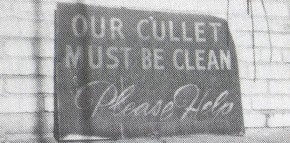
Figure 32
Sign at Muncie left over from Hemingray era
May 1981
(Courtesy of N. R.
Woodward)
Covington seems to have been largely a cullet
(waste glass) operation, so most of the color variety results from using cullet
when making up batches of glass. (Cullet was also used to a certain extent at
Muncie, as Figures 32 and 33 show.) Cullet is used in all glassworks'. It is
possible to make glass entirely from cullet; but it is not practical to make it entirely from raw materials. For some reason, cullet is needed to make the
mix fuse and blend properly. Additionally, after completing an order for other
glass products in a certain color, the glassmaker would often use the leftover
glass to make insulators. Color variety also resulted, for example, when they
were making amber bottles and changed to insulators, and as the amber glass
ran out, it was replaced by other glass. '!his created the various shades, as
added materials mixed with the last of the amber. These two reasons are why it is more
difficult to get the darker colors in insulators, especially in the H. G. CO.
PETTICOAT beehives.
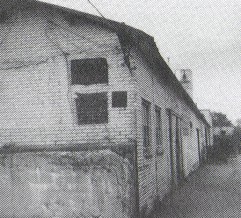
Figure 33
Cullet shed at Muncie showing
original position of sign (top)
May 1981
It is doubtful that "our" beehives were made
intentionally in various colors. Standard telegraph insulators were not made in
special colors. The CD 162 and 164 were so advertised, as marker insulators,
but there would be no need for a CD 145 marker insulator. (Not much cullet was
used in the very earliest of the Hemingray insulators. The old No.1, 2, and 3
telegraph insulators with only numbers on them are of rather uniform aqua, and made
from good-quality sand.) And later on, after "our" beehives ceased
being produced, the color became standardized, often requested as such by
purchasers. In specifications from Western Electric dated 1911, under
"Material", they state, "The insulators shall be made of
transparent colorless or green [aqua] glass."
The
"end-of-day-glass" theory doesn't hold much water, for firing up those
furnaces took time, and once going, it was pretty much a continuous (night and
day) operation. They were only shut down for periodic inspections, cleaning, or
repairs. At least in the larger companies like Hemingray, insulators were being made by the tens of thousands, and once in operation, the furnaces would
be kept hot; they did not shut down every evening. Often people do not
comprehend the magnitude of the insulator-making at Hemingray,
Brookfield, etc. They do not visualize the enormous furnaces gobbling up
sand by the carload, nor the trainloads of insulators leaving the plant. (See
Figures 34 and 35)
H. G. CO. PETTICOAT beehives have been located in so many
colors that it is easier to list those in which they don't come, rather than
those in which they do. This is no doubt an incomplete list, but comparatively
speaking, even if I've unwittingly omitted a few colors, the list is short. These
are colors I have not seen, or had verified: True yellow or straw (with
absolutely no green), peacock, cobalt, indigo (dark purplish blue) , true
cornflower, true olive, red or dark brown amber (without any orange or yellow) ,
and mustard. There are other colors (like red, black, etc.), but they are not
standard glass insulator colors.
EFFICIENCY OF DESIGN
The beehive, and especially the H. G. CO. PETTICOAT beehive, proved to be
a very efficient design. The sloping sides directed moisture outward and away from the wood pin, and the wire groove was positioned so as
to minimize strain on the pin from the wire. Herein lies the difference between
Western Union and Postal philosophy. WU used a higher wire groove (in the later
Muncie style) with the longer leakage path, but greater strain on the pin and
more pin failures. Postal used the low groove, shorter leakage path, but better
balance to minimize pin strain. The H. G. CO. PETTICOAT was closer to the
Postal philosophy in that respect.
There are only a few designs considered
"perfect" as far as being balanced and pleasing to the eye. Some are
manmade; some are not. They are: The equilateral, triangle, the giraffe, and
the original, six-ounce Coke bottle. These things have something in common...
the phenomenon known as "eye directives". In my opinion, the H. G. CO.
PETTICOAT beehive should be added to this list, because it fits the criteria by which the others are judged; it is
perfectly balanced, and its design causes the human eye to "want" to
follow the lines. Even other beehives may appear ei ther top or bottom heavy,
but this is not true of this beehive.
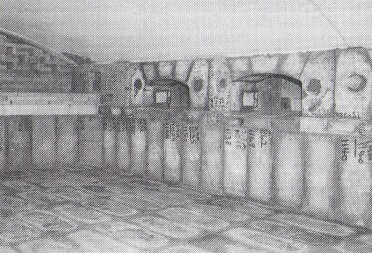
Figure 34
'!he interior of "B" furnace at Muncie, built in 1904
West side looking
south
(Shut down for repairs)
c. 1918
(Courtesy of Ruth and Jim Crawford)
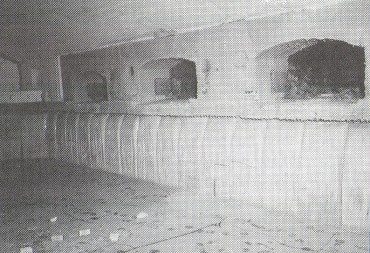
Figure 35
Same as Figure 34
c. 1930
(Courtesy of Ruth and Jim Crawford)
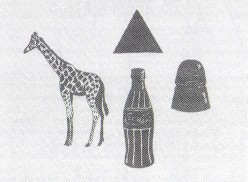
DISTRIBUTION
Due to the strategic location of the factory at Covington, these beehives
were widely distributed throughout the United states, and some even made their way into Mexico. Having been manufactured during the
formative years (communication-wise) of the Midwest and West, they played an
important role in the expansion of these areas. And although their numbers are
dwindling rapidly, some can sometimes still be found in service along the
railroad on telegraph and signal lines, as well as on telephone circuits. But
today many lines are underground, and communication via fibre optic cables is
increasing, so these little treasures soon will no longer be needed.
IN CONCLUSION
There is more history to be found, and more to be told about these beehives,
but perhaps I will leave that to a future historian. But we have learned much
about them, including how they came to be, their age, their years of production,
meanings of their embossings, data on their colors, design, distribution, and
more. This much we do know for certain; these colorful "regular paraboloids"
are a favorite of many of us. And after more than a century of labor, they now
can enjoy a cozy retirement in the collections of insulator buffs like you and
me.
IN APPRECIATION
My deepest gratitude and thanks go to Mr. N. R. "Woody" Woodward
and Mr. Glenn Drummond. Their contributions to our hobby are legendary. I have
the highest respect for their intelligence, humor, and total generosity with
their vast knowledge. They have been so willing to share with me everything
they've learned from their many years of research. Their respective interests in
insulators and in insulator history may vary, but they brought those interests
together for me into one subject, and not once has either of them shown the slightest reluctance to give me (or others) the benefit of their labors. Also,
neither one of them ever asked for or expected credit for helping me. So, I
sincerely would like to thank Messrs. Woodward and Drummond for your assistance,
without which this article never could have gotten off the ground. Most of what
is written here came from you. THANX!
I also thank my brother-in-law, Roger Inselman, for the title photo (among others throughout the article),
and for
the computer graphics in the title and paragraph headings. They all look
great!
And last but not least, I thank my husband, Mr. Hyve (Wes Gordon), who
did most of the housework during those times I was working on this project, so
that I could concentrate. Also, he made hundreds of trips to the print shop getting illustrations reduced,
enlarged, or copied, and just about as many
trips to another shop to have items screened or PMT'd, along with several
jaunts to the library. My thanks to all of you!
Cover Photo (January, 1996) of Daniel C. Hemingray courtesy of the
Cincinnati Historical Society. Permission granted to color photo. Floral design by
Donna Allan of San Diego, CA.
|
